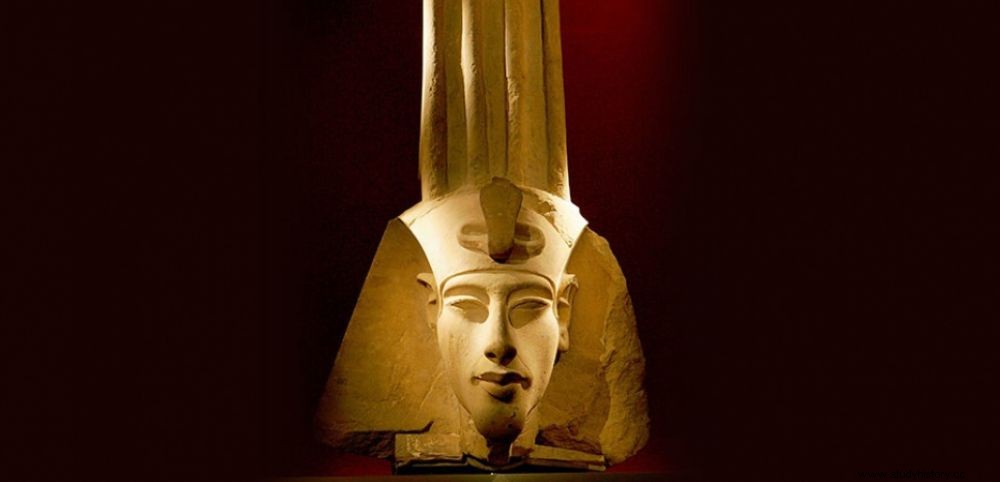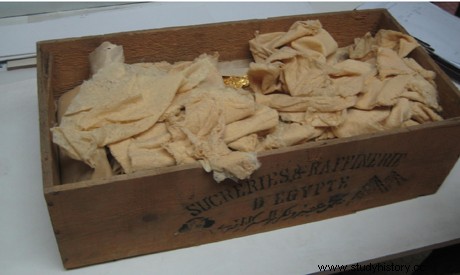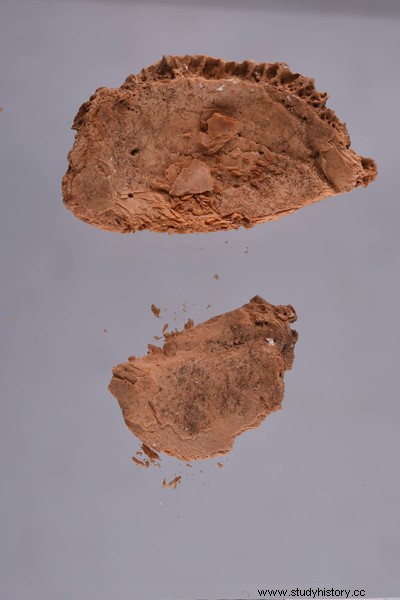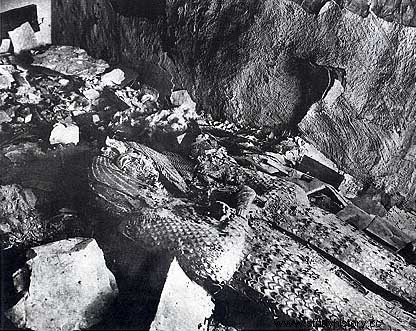 Statue of Akhenaten (Amenhotep IV), the "heretic" pharaoh of the Eighteenth Dynasty.
Statue of Akhenaten (Amenhotep IV), the "heretic" pharaoh of the Eighteenth Dynasty. GOLD LEAVES. It is a mystery over 110 years old that Egyptologists are preparing to solve. And to achieve this, the American Research Center (ARCE) has just released $28,500 to finance the study of 500 gold sheets, at the request of officials from the Cairo Museum and the Ministry of Egyptian Antiquities. But how can these gold leaves help unravel an archaeological imbroglio? This is because according to the ministry, these precious gildings could have a direct link with the identification of the tomb of Akhenaten (Amenhotep IV) (1346-1329 BC), the famous pharaoh of the XVIII th dynasty, father of Tutankhamun! The supposed tomb of this ruler is indeed one of the most controversial burials in ancient Egypt.
The outcome of this new work should prove that the occupant of the mysterious tomb KV55, discovered in the Valley of the Kings, in the heart of the Theban necropolis, at the beginning of the XX th century, is indeed Akhenaten, the "heretic" pharaoh. He who in less than two decades had broken with two millennia of beliefs, by deciding to abandon the cult of Amun-Re, to go and found, in the middle of the middle-Egyptian desert, a city, by imposing a new cult on the sun god Aten.
 Crate with gold leaves recently discovered in the Cairo Museum. They come from tomb KV55 in the Valley of the Kings (©ministry of Antiquities).
Crate with gold leaves recently discovered in the Cairo Museum. They come from tomb KV55 in the Valley of the Kings (©ministry of Antiquities).
"A few months ago, curators and restorers at the museum in Tahrir Square, Cairo, got their hands on a wooden crate that contained several hundred gold leaf, a fragment of skull bone and other organic and mineral elements" , explains Egyptologist Marc Gabolde, of Paul Valéry-Montpellier III University.
 Cranial bone fragments related to gold leaf finds from tomb KV 55. © ministry of Antiquities
Cranial bone fragments related to gold leaf finds from tomb KV 55. © ministry of Antiquities
An initial analysis of these objects led by Elham Salah, allowed Egyptian curators to relate these gold leaves to the admirable sarcophagus encrusted with fine stones found in the grave KV 55 by Edward Russel Ayrton and Theodore M. Davis, 1907. identified in the past at the Cairo Museum, and partly studied" , adds Marc Gabolde. In addition, some other gold leaf had also been transmitted to the Metropolitan Museum of Art in New York (USA) by Theodore M. Davis when sharing the contents of the burial, as was done at the time between Egypt and the Discovering Nations. While a large group, since returned to Egypt, ended up in Munich (Germany). "The lot recently found would therefore be the complement of these elements and it should make it possible to reconstruct a very large part of the decoration and the inscriptions of the exterior and, above all, of the interior of the coffin", continues the archaeologist.
It so happens that in antiquity, this coffin, now exhibited in the Cairo Museum, was modified to accommodate the remains of a king... (At the originally it was intended for Kiya, a secondary wife of Akhenaten). "Since its discovery, many hypotheses have been formulated about the identity of the last occupant of the coffin as well as its mummy, very damaged, and reduced to the state of a skeleton" , said Marc Gabolde.
 The very degraded sarcophagus, photographed at the time of its discovery, in 1907, in tomb KV55 of the royal necropolis of the Valley of the Kings.
The very degraded sarcophagus, photographed at the time of its discovery, in 1907, in tomb KV55 of the royal necropolis of the Valley of the Kings.
In antiquity, after his burial in tomb KV 55 in the Valley of the Kings, this burial was desecrated, and its cartouches (titulatures), as well as the face in the coffin were deliberately mutilated, making the occupant anonymous... But what powerful character could he have triggered so much resentment during his lifetime, so that once dead, some wanted to disfigure him for eternity? " For a time, Egyptologists favored the name of the mysterious king Smenkhkare , says Marc Gabolde. But today, scientists are more inclined to consider it to be Akhenaton's remains, which is also my opinion after examining in detail the inscriptions on the canopic jars found with the coffin " , concludes the Egyptologist.
DNA tests carried out on this mummy in 2010, under the direction of Zahi Hawass, had already established that this male individual was the son of Amenhotep III and Queen Tiyi, as well as Tutankhamun's father, and therefore Akhenaten. "The examination of these gold leaf fragments and this new study may now help to clarify the history of this sarcophagus, and – it is the hope of all –, to definitively identify the deceased interred in tomb KV55" , hopes Marc Gabolde.
KV55, a problematic grave
Discovered in 1907, tomb KV55 contained a large quantity of royal funerary material belonging to the 18
th
dynasty, including a large gilded wooden coffin, canopic jars (in which were kept the embalmed viscera of the deceased). This hypogeum would have served as a hiding place for members of the royal family brought back from the necropolis of Amarna, the ephemeral city built far from Thebes by Akhenaten, the pharaoh of the New Kingdom. In 1992-1993, during a new study, Lyla Pinch Brock, a Canadian archaeologist, unearthed a painted ostracon (ceramic fragment), on which was part of the original plan of the ancient tomb.
